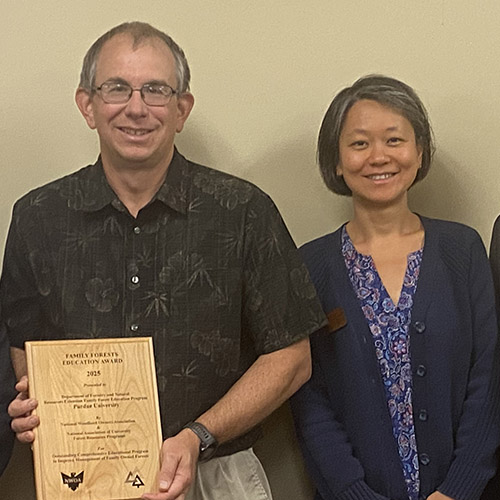2021 Year in Review: The Research
Facility Improvements
New buildings, upgraded facilities and infrastructure work for research have been ongoing at two off-campus Forestry and Natural Resources properties over the last year.
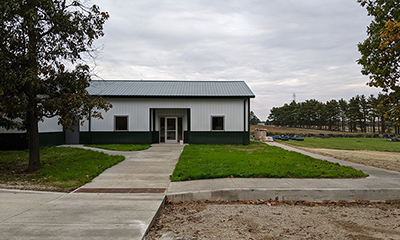 The Wildlife Ecology Research Facility (WERF) features animal care rooms, which are designed to allow users to study a wide range of aquatic and terrestrial species and research questions in ecology, ecotoxicology, and disease ecology, will be completed and operational in early spring 2022.
The Wildlife Ecology Research Facility (WERF) features animal care rooms, which are designed to allow users to study a wide range of aquatic and terrestrial species and research questions in ecology, ecotoxicology, and disease ecology, will be completed and operational in early spring 2022.- Another FNR property where improvements are ongoing is Martell Forest. Infrastructure for on-site personnel, as well as preparations for upcoming research, are taking place at the site, located 8.5 miles from campus.
The Purdue Wildlife Area, a 290-acre property of prairie, wetlands, savannah and woodlands, located 15 minutes west of campus, will expand its reach with the building of a small observatory in collaboration with the Department of Physics and Astronomy.
Major Grants
 Jingjing Liang, assistant professor of quantitative forest ecology, is aiming to improve the accuracy of the current map of planted forests in China and fill in the gaps about the dominant species, while quantifying the carbon storage through a new grant "Mapping Planted Forests in China," funded by the World Resources Institute.
Jingjing Liang, assistant professor of quantitative forest ecology, is aiming to improve the accuracy of the current map of planted forests in China and fill in the gaps about the dominant species, while quantifying the carbon storage through a new grant "Mapping Planted Forests in China," funded by the World Resources Institute.
Conservation cost sharing programs are intended to encourage invasive plant control in non-industrial private forests and other lands by providing financial assistance to cover the cost of control to individual landowners. A new research project by Drs. Mo Zhou, Mike Jenkins and Jingjing Liang as well as forester Don Carlson will look into the actual impact these programs have on containment or reduction of biological invasion, especially in timberlands.
Reducing the spread of CWD from source populations and affected areas to uninfected populations and CWD-free areas through management actions is key for long-term deer population management in Indiana and beyond. Dr. Pat Zollner, professor of wildlife science, is among a group of researchers aiming to assist with the mitigation process through a new grant funded by the Indiana Department of Natural Resources.
Dr. Jacob Hosen is in the midst of a two-year project sponsored by the National Science Foundation titled "Collaborative Research: MSA: Uncovering Local and Regional Controls on Organic Matter Processing in Freshwaters Using In Situ Optical Sensors."
Dr. Bryan Pijanowski began work on a three-year project "CNH2-L: Using Sound to Advance Conceptual Frameworks of Resilience of Integrated Grassland-Pastoralist Systems" in May 2021. The project is sponsored by the National Science Foundation.
Dr. Zhao Ma and former postdoc Anna Erwin are set for a two-year project "The Indiana Farmworker Resiliency Project: Organizational Opportunities and Challenges during COVID-19," sponsored by the National Institute of Food and Agriculture.
Dr. Linda Prokopy's project "Evaluation of Farmer-to-Farmer Networks" sponsored by The Nature Conservancy began in January 2021.
Dr. Mo Zhou is co-principal investigator with Dr. Carson Reeling, associate professor of agricultural economics, on a project titled "An Integrated Economic Assessment of Outdoor Activities Related to White-Tailed Deer and Furbearer in Indiana." The three-year project, which also includes Dr. Rob Swihart and Dr. Zhao Ma as investigators, is sponsored by the Indiana Department of Natural Resources.
Dr. Paul Brown and aquaculture research lab manager Bob Rode received a grant from the North Central Regional Aquaculture Center for a two-year study, "Intensification of first year largemouth bass (Micropterus salmoides) using alternative pond-based production systems" in conjunction with SIU-Carbondale and The Ohio State University.
FNR Research In the Media
Dr. Linda Prokopy's research on drought was featured in the Institute of Agriculture and Natural Resources News article "Study: Ranchers with Drought Plans Make Some Pivotal Moves Sooner."
Dr. Zhao Ma was part of a research group that surveyed faculty across the nation to see how the COVID-19 pandemic affected them.
Graduate student Becca Nixon's research on cost of climate change adaptations in Pakistan was featured in this graduate student spotlight and in the article "Student's Travels and Research Clarify Cost of Pakistan's Climate Change Adaptations."
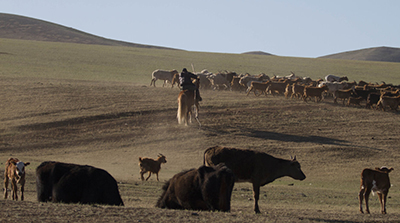 Dr. Bryan Pijanowski, Director of the Purdue Center for Global Soundscapes work research on "How Sound Drives Mongolian Herder Cultural Practices" was featured. Pijanowski also spoke on The Animal Turn podcast about soundscape and sound ecology.
Dr. Bryan Pijanowski, Director of the Purdue Center for Global Soundscapes work research on "How Sound Drives Mongolian Herder Cultural Practices" was featured. Pijanowski also spoke on The Animal Turn podcast about soundscape and sound ecology.
Dr. Jeff Dukes and his Practice of Assessments Working Group's efforts to coordinate climate change efforts centered on cities, states and regions, were featured in "Weaving a stronger fabric of climate assessments."
Dr. Paul Brown, professor of fisheries and aquatic sciences, was recently interviewed by Jon Reyes, Communications Director for the Aquaponics Association, as part of the People of Aquaponics series on the Aquaponics AI YouTube channel. Brown spoke about the future of aquaponics, aquaculture and fish feed. Brown was one of five aquaponics experts nominated to serve on the USDA's new Advisory Committee on Urban and Innovative Agriculture.
Lab manager Matt Hamilton's work in FNR was featured in a College of Ag Behind the Research story and also in "Organizational Leadership Grad Branches Out From Lab Management to Natural Resources Research."
Dr. Jeff Dukes penned an opinion piece with John Ketzenberger in the Indiana Business Journal titled "Climate change solutions can be grown in Indiana." Dukes later participated in an IBJ podcast "Climate change could scorch and soak Indiana while reshaping key industries."
Dr. Tomas Hook shared about erosion on the shoreline of Lake Michigan in a WFYI All-In Podcast.
Dr. Jeff Dukes talked about how climate change is affecting the state of Indiana in a WFYI All-In Podcast.
The Purdue Exponent provided a look at how Dukes is reducing his own carbon footprint in the article "Community members reflect on their carbon footprint."
Dr. Pat Zollner and PhD student Marian Wahl's work on black vulture ecology, was highlighted by Smithsonian Magazine and the NY Times among other publications and media outlets. The pair and undergraduate research assistants Gabrielle Dennis and Danielle Jones were also featured in a pictorial titled "A Day on the SIPAC Farm" and announced the need for citizen participation in their research. Dr. Zhao Ma and PhD student Brooke McWherter are involved in the social science component of the project.
Urban forester Lindsey Purcell was quoted in the Purdue Exponent story "Urban Forestry Focused on Creating Urban Forest." He also shared about pine cone abundance in Michiana in the South Bend Tribune.
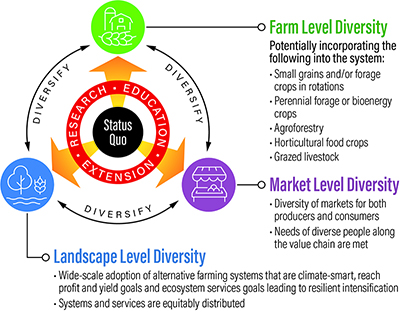 Research on cover crops conducted by Dr. Linda Prokopy and former postdoctoral research Ruxandra Popovici was highlighted in the article "Field Work: The Magical Dividing Line Between Counties" in the Ag Web Farm Journal. Prokopy later was part of a collaborative research group which was awarded $10 million for their Diverse Corn Belt project, which seeks to make agriculture more resilient by diversifying farms, marketing and the agricultural landscape.
Research on cover crops conducted by Dr. Linda Prokopy and former postdoctoral research Ruxandra Popovici was highlighted in the article "Field Work: The Magical Dividing Line Between Counties" in the Ag Web Farm Journal. Prokopy later was part of a collaborative research group which was awarded $10 million for their Diverse Corn Belt project, which seeks to make agriculture more resilient by diversifying farms, marketing and the agricultural landscape.
The Help the Hellbender program was spotlighted in a Kokomo Tribune article about the summer release of juveniles into the Blue River.
The Digital Forestry Initiative led by Dr. Songlin Fei was featured in "Remote sensing, digital tech advance tools for precision forestry."
Illinois-Indiana Sea Grant's Kara Salazar is joining with Minnesota and Pennsylvania Sea Grant on a newly funded project to implement multi-benefit green infrastructure in marginalized neighborhoods across the Great Lakes.
Dr. Jake Hosen was part of an article in WBAA regarding his wetlands research.
Graduate student Brooke McWherter and her research were featured in this Graduate Ag Research Spotlight. Brooke is a fourth-year PhD student in Dr. Zhao Ma's Human Dimensions Lab. Her dissertation research addresses the role of trust, reciprocity and conditionality in watershed conservation efforts in Bolivia and the role of trust, emotions, and other social factors in human-wildlife interactions in Indiana and Kentucky.
Master's degree student Marissa Cubbage's collaboration with tribal biologists from the Little Traverse Bay Band of Odawa Indians to complete her research on the "impacts of altered zooplankton on abundance and community composition of larval fish." The research looks at the how zooplankton declining in the lakes, due to decreased nutrient loading and the filtration of nutrients and phytoplankton by invasive mussels, has affected the diet of the larval coregonid fish.
Funded in part by a Purdue Climate Change Research Center graduate student travel grant, Benjamin Gottesman, and advisor Dr. Bryan Pijanowski traveled to southwest Puerto Rico where they deployed acoustic recorders to explore the soundscape dynamics in adjacent marine and terrestrial coastal habitats. Their plans changed when Hurricane Maria, a powerful category 5 storm, tore through the island and they directed their focus on the impact of this intense disturbance event.
FNR Presentations
Megan Gunn participated in the Invasive Species Symposium on Oct. 22.
Dr. Jake Hosen and Dr. Tyler Hoskins, a post-doctoral researcher, spoke at the "Indiana Wetlands II: Where are they now?" virtual forum on Oct. 5. Hoskins shared about Wetlands impacts from contaminants and pollution: water quality and animal life, while Hosen spoke on wetland ecoservices: climate resilience and carbon storage.
Dr. Matt Ginzel provided an overview of identification, impact and management strategies for Thousand Cankers Disease in the southeastern United States as part of the Forest Health Southern Regional Extension Forestry webinar series.
Dr. Doug Jacobs chaired the first session of the Forest Seedling Root Symposium presented by the Western Forestry and Conservation Association in October.
The Integrated Deer Management Project presented four webinars during September and October, introducing the IDMP and its work with monitoring deer populations and deer habitat and the human dimensions of deer management. Speakers included project manager Pat McGovern and graduate students Zach Delisle, R.D. Sample and Taylor Stinchcomb.
Stinchcomb presented "Complex Human-Deer Interactions in Indiana Require Innovative Approaches to Deer Management" at the Wildlife Society Conference in November. She also participated in a related live Q&A for the Human Dimensions II session. Dr. Rod Williams was part of a panel titled "Outreach in the Virtual World: Tips, Tricks, Pitfalls and Successes" at the TWS event.
 With discussions on what collective action must be taken to decrease fossil fuel emissions that lead to warming and extreme weather events happening on the world stage, the Purdue Climate Change Research Center (PCCRC) released animations to illustrate what is happening in Indiana. Graduate student Andrea Nebhut explained her motivation for and methods of creating the animations.
With discussions on what collective action must be taken to decrease fossil fuel emissions that lead to warming and extreme weather events happening on the world stage, the Purdue Climate Change Research Center (PCCRC) released animations to illustrate what is happening in Indiana. Graduate student Andrea Nebhut explained her motivation for and methods of creating the animations.
Drs. Rado Gazo and Eva Haviarova along with Purdue Extension wildlife specialist Jarred Brooke and forester Lenny Farlee presented educational sessions at the Hoosier Hardwood Festival in Marion County, Indiana in August.
Dr. Jason Hoverman presented a program on "Stream health and aquatic invertebrates" as part of the Lily Nature Center's Wednesday's in the Wild series, and presented "Isolated wetlands as a critical wildlife habitat" as part of a series, The Value of All Wetlands: Indiana Researchers Weigh In, for the Purdue Center for the Environment.
Hoverman also presented "Aquatic systems as a tool for evaluating the toxicity of PFAS-free AFFF" and "The relative toxicities of current use aqueous film forming foams and next generation alternative to aquatic species for informing risk assessment" to the Department of Defense.
Purdue Extension wildlife specialist Brian MacGowan offered up non-game wildlife habitat hints as part of the Ohio River Valley Woodlands and Wildlife Workshop on March 27.
Dr. Barny Dunning demonstrated bird banding at the Purdue Wildlife Area as part of the Tippecanoe County Master Naturalist Program.
Carolyn Foley presented on Incorporating Justice, Equity, Diversity and Inclusion into Research and Fellowship Competitions at the International Association for Great Lakes Research conference.
FNR Outreach/Extension Efforts
Purdue Extension specialists reached 75,000 viewers through the FNR website, social media and YouTube through several video series.
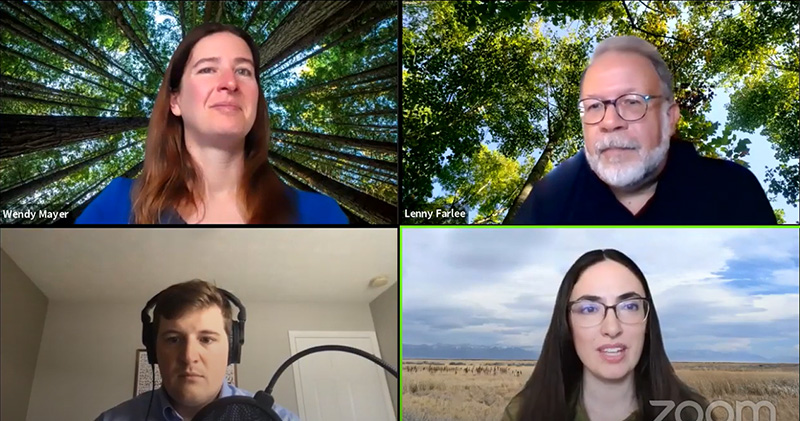 Ask the Expert: 5,737 views across nine live sessions
Ask the Expert: 5,737 views across nine live sessions- ID That Tree: Extension forester Lenny Farlee produced 53 videos in 2021, garnering 26,996 views
- Woodland Management Moment: Farlee's series covering invasive species and other woodland management items such as selling timber, marking property lines and building deer fencing, garnered 3,946 views
- A Moment in the Wild: Dr. Rod Williams and Nick Burgmeier presented this four-video series on salamanders and habitat issues, earning 2,425 views
- Woodland Stewardship for Landowners: Three videos from this collaborative series between FNR and the Indiana Department of Natural Resources, earned a total of 1,415 views.
Extension Publications
Are Farmed Trout Safe to Eat? - Amy Shambach, Aquaculture Marketing Outreach Associate
Pacific White Shrimp - Amy Shambach, Aquaculture Marketing Outreach Associate
Invasive Plant Series: Swallow-worts – Ron Rathfon, Regional Extension Forester, Southern Indiana Purdue Agriculture Center
Tilapia Farmed Fish Fact Sheet - Amy Shambach, Aquaculture Marketing Outreach Associate
New Curriculum Available: How Human Impact Gene Flow and Genetic Diversity – Dr. Rod Williams, Dr. Jason Hoverman
What's Wrong with Topping Trees – Lindsey Purcell, Urban Forestry Specialist
Creating a Wildlife Habitat Management Plan for Landowners – Jarred Brooke, Extension wildlife specialist
A Template for Your Wildlife Habitat Management Plan – Jarred Brooke, Extension wildlife specialist
Yellow Perch Becoming Popular - Amy Shambach, Aquaculture Marketing Outreach Associate
Fish is a Healthy Choice, View Quick Guide to Ensure Freshness and Benefits - Amy Shambach, Aquaculture Marketing Outreach Associate
Transporting Food Waste – Dr. Rod Williams
Sustainable Aquaculture: What Does it Mean to You? - Amy Shambach, Aquaculture Marketing Outreach Associate
Walleye Farmed Fish Fact Sheet: A Guide for Seafood Consumers - Amy Shambach, Aquaculture Marketing Outreach Associate
Tree Defect Identification – Lindsey Purcell, Urban Forestry Specialist
FNR Publications
Zhao Ma, former post-docs Ruxandra Popovici and Anna Erwin, Dr. Linda Prokopy and postdoc Pranay Ranjan, published a paper "How do Indigenous and local knowledge systems respond to climate change?" in Ecology and Society.
Ma, Popovici and Erwin also published "Maladaptive Learning in Peru's Integrated Water Resources Management" about their findings regarding the case of decision makers and water users in Peru, in Environmental Science and Policy. They also discussed the research in this article..
Ma also was part of Smith Fellows postdoc Rebecca S. Barak's research on "Factors influencing seed mix design for prairie restoration," which was published in Restoration Ecology in October 2021.
 Former DeWoody Lab postdoc Anna Brüniche-Olsen, along with Drs. Ken Kellner and Jerry Belant at SUNY ESF, have published a paper that shows how whole-genome sequencing data can yield metrics relevant to contemporary conservation efforts in birds. Purdue FNR affiliated researchers compiled whole genome sequences, habitat availability data and life-history trait data (such as body mass and diet) for 68 bird species to find out how biological and environmental conditions have shaped genomic diversity and why genomic diversity differs among species in order to provide insights for future conservation efforts.
Former DeWoody Lab postdoc Anna Brüniche-Olsen, along with Drs. Ken Kellner and Jerry Belant at SUNY ESF, have published a paper that shows how whole-genome sequencing data can yield metrics relevant to contemporary conservation efforts in birds. Purdue FNR affiliated researchers compiled whole genome sequences, habitat availability data and life-history trait data (such as body mass and diet) for 68 bird species to find out how biological and environmental conditions have shaped genomic diversity and why genomic diversity differs among species in order to provide insights for future conservation efforts.
Researchers from DeWoody's lab, including former graduate student Samarth Mathur, investigated the genetic diversity of different sized Montezuma quail populations from the desert Southwest. They looked at the consequences of a lack of diversity, including the capacity to adapt to ecological stressors, as well as overall fitness and population prosperity due to genetic erosion. The research produced two publications: Genetic load has potential in large populations but is realized in small inbred populations and An evolutionary perspective on contemporary genetic load in threatened species to inform future conservation efforts.
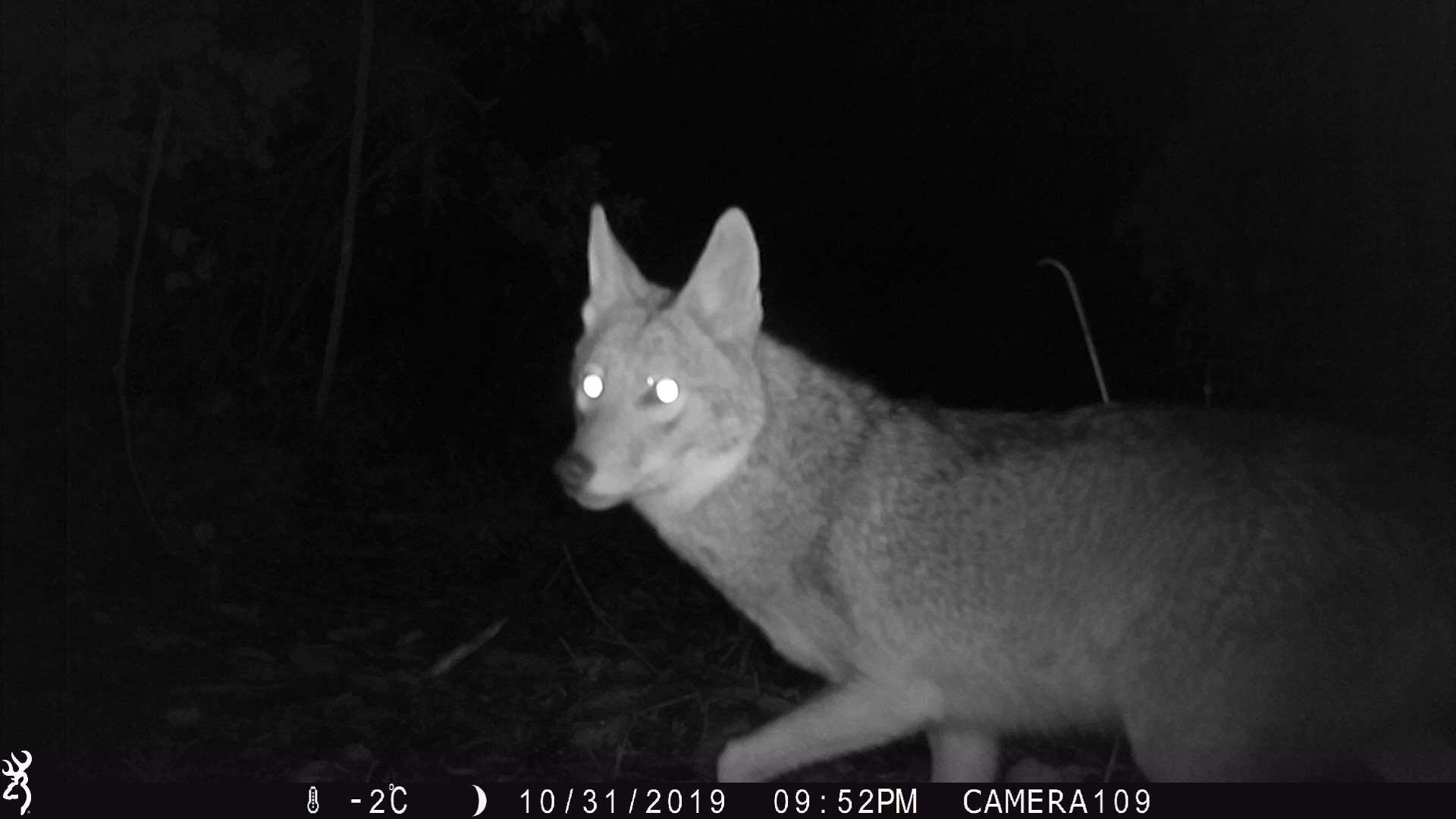 Dr. Elizabeth Flaherty, associate professor of wildlife ecology and habitat management, and Purdue Extension wildlife specialist Jarred Brooke collaborated to collect the photos from Richard G. Lugar Forestry Farm, Martell Forest and the Purdue Wildlife Area as part of the first-ever nationwide wildlife survey, called Snapshot USA. The results of the survey were published in Ecology, in an article titled "SNAPSHOT USA 2019: a coordinated national camera trap survey of the United States."
Dr. Elizabeth Flaherty, associate professor of wildlife ecology and habitat management, and Purdue Extension wildlife specialist Jarred Brooke collaborated to collect the photos from Richard G. Lugar Forestry Farm, Martell Forest and the Purdue Wildlife Area as part of the first-ever nationwide wildlife survey, called Snapshot USA. The results of the survey were published in Ecology, in an article titled "SNAPSHOT USA 2019: a coordinated national camera trap survey of the United States."
Flaherty and Dr. Rob Swihart, along with Ph.D. student Zach Delisle and undergraduate students Mackenzie Nobbe and Cole Wzientek, published a review of wildlife research applications of camera trapping in Frontiers in Ecology and Evolution titled "Next-generation camera trapping: Systematic review of historic trends suggests keys to expanded research applications in ecology and conservation." The article assessed changes in camera trap use through the lens of technological diffusion and has received >6,500 views.
Swihart also coauthored a publication, led by FNR alum Jackie Doyle and her student, Miracle Davis and including FNR alums Tim Smyser and Joe Duchamp as coauthors, titled "Reproductive success of captive-reared Allegheny woodrats (Neotoma magister) released into genetically depauperate populations," in Conservation Genetics.
Rian Bylsma, who earned his master's degree in fall 2020, had his thesis work "Population genetic and genomic analyses of Western Massasauga (Sisturus tergeminus ssp.): implications for subspecies delimitation and conservation.," published in Conservation Genetics.
Dr. Jeff Dukes and Maria Del Rosario Uribe Diosa co-authored "Seasonality of Tropic Photosynthesis: A Pantropical Map of Correlations with Precipitation and Radiation and Comparison to Model Outputs," which was published in JGR Biogeosciences, Volume 126, Issue 11. The article examines the seasonality of photosynthesis in tropical ecosystems.
Master's degree alumnus Jake Hawes (2019) published "Social Vulnerability to Irrigation Water Loss: Assessing the Effects of Water Policy Change on Farmers in Idaho, USA" in Environmental Management. The paper was a chapter from his thesis.
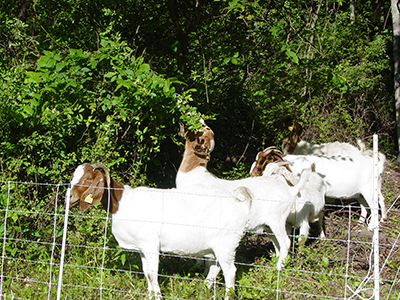 Extension forester Ron Rathfon tested goat grazing as a method to control a continuous stand of mature, dense multiflora rose in the understory of one of the timber stands at the Southern Indiana Purdue Agricultural Center (SIPAC). The results of Rathfon's five-year experiment were recently published in the journal Restoration Ecology (Volume 29, Issue 4, May 2021) in an article titled "Effects of prescribed grazing by goats on non-native invasive shrubs and native plant species in a mixed hardwood forest." Rathfon co-authored the publication with professor of forest ecology Dr. Mike Jenkins, and master's degree alumna Skye Greenler.
Extension forester Ron Rathfon tested goat grazing as a method to control a continuous stand of mature, dense multiflora rose in the understory of one of the timber stands at the Southern Indiana Purdue Agricultural Center (SIPAC). The results of Rathfon's five-year experiment were recently published in the journal Restoration Ecology (Volume 29, Issue 4, May 2021) in an article titled "Effects of prescribed grazing by goats on non-native invasive shrubs and native plant species in a mixed hardwood forest." Rathfon co-authored the publication with professor of forest ecology Dr. Mike Jenkins, and master's degree alumna Skye Greenler.
Sharing and reporting benefits from biodiversity research. Dr. Andrew DeWoody in Molecular Ecology 30:1103-1107.
Influence of Holocene habitat availability and commercial whaling on Pacific gray whale (Eschrichtius robustus) population dynamics as inferred from whole mitochondrial genome sequences and environmental niche modelling. Anna Brüniche-Olsen, alumnus Dr. Ken Kellner, Dr. Andrew DeWoody in Journal of Mammalogy 102: 986-999.
The endangered White Sands pupfish (Cyprinodon tularosa) genome reveals low diversity and heterogenous patterns of differentiation. Andrew Black, Janna R. Willoughby, Brüniche-Olsen and DeWoody in Molecular Ecology Resources 21:2520–2532.
The long-standing significance of genetic diversity in conservation. Samarth Mathur, Willoughby and DeWoody in Molecular Ecology 30:4147–4154.
Population genetic and genomic analyses of Western Massasauga (Sistrurus tergeminus ssp.): implications for subspecies delimitation and conservation. Rian Bylsma, Black, and DeWoody in Conservation Genetics, in press.
Improving the Biodiversity in Urban Green Spaces: A Nature Based Approach. Dr. Barny Dunning in Ecological Engineering 173: 1-8.
A Tippecanoe rarity: in-depth analysis of an unlikely inland Brant (Branta bernicla). Undergraduates Amanda Heltzel and Alexis Proudman, Dunning in Indiana Audubon Quarterly, 99(3):6-13.
Restore prairie on your property to protect history, wildlife and humanity. Master's alum Zach Finn in The Woodland Steward 29 (2): 8-9, 14.
Spatial patterns in dry weight of nearshore Lake Michigan prey fishes. Carolyn Foley in Journal of Great Lakes Research, 47(6), 1836-1843.
2021 CSMI Lake Michigan Prospectus. Foley and Dr. Paris Collingsworth.
 Chronic Per-/Polyfluoroalkyl Substance Exposure Under Environmentally Relevant Conditions Delays Development in Northern Leopard Frog (Rana pipiens) Larvae. R. Wesley Flynn, Michael Iacchetta, Dr. Marisol Sepulveda, Dr. Jason Hoverman in Environmental Toxicology, Volume 40, Issue 3, p. 711-716
Chronic Per-/Polyfluoroalkyl Substance Exposure Under Environmentally Relevant Conditions Delays Development in Northern Leopard Frog (Rana pipiens) Larvae. R. Wesley Flynn, Michael Iacchetta, Dr. Marisol Sepulveda, Dr. Jason Hoverman in Environmental Toxicology, Volume 40, Issue 3, p. 711-716
Consistent effects of pesticides on community structure and ecosystem function in freshwater systems. Hoverman in Nature Communications, Article 6333 (2020).
Dynamic spatio-temporal patterns of metapopulation occupancy in patchy habitats. Hoverman in Royal Society Open Science, 8 (1).
Perfluoroalkyl substances increase susceptibility of northern leopard frog tadpoles to trematode infection. Hoverman in Environmental Toxicology and Chemistry, 40 (30), 689-694.
Population-level variation in infection outcomes not influenced by pesticide exposure in larval wood frogs (Rana sylvatica). Master's alumnus Logan Billet, Hoverman in Freshwater Biology, 66 (6), 1169-1181.
Predator- and competitor-induced responses in amphibian populations that evolved different levels of pesticide tolerance. Hoverman in Ecological Applications, 31 (4), e02305.
Relative acute toxicity of three per- and polyfluoroalkyl substances on nine species of larval amphibians. Undergraduate alumna Megan Gannon, Hoverman, Dr. Marisol Sepulveda in Integrated Environmental Assessment and Management, 17 (4), 685-690.
Sublethal effects of dermal exposure to poly- and perfluoroalkyl substances on postmetamorphic amphibians. Sarah Abercrombie, Michael Iacchetta, R. Wesley Flynn, Hoverman, Sepulveda in Environmental Toxicology and Chemistry, 40 (3), 717-726.
Dietary exposure and accumulation of per- and polyfluoroalkyl substances alters growth and reduces body condition of post-metamorphic salamanders. Flynn, Dr. Tyler Hoskins, Iacchetta, Hoverman, Sepulveda in Science of The Total Environment, 765, 142730.
Relative acute toxicity of three per- and polyfluoroalkyl substances on nine species of larval amphibians. Gannon, Hoverman, Sepulveda in Integrated Environmental Assessment and Management, 17 (4), 684-690.
Chronic Per-/Polyfluoroalkyl Substance Exposure Under Environmentally Relevant Conditions Delays Development in Northern Leopard Frog (Rana pipiens) Larvae. Flynn, Iacchetta, Hoverman, Sepulveda in Environmental Toxicology and Chemistry, 40 (3), 711-716.
Sublethal Effects of Dermal Exposure to Poly- and Perfluoroalkyl Substances on Postmetamorphic Amphibians. Abercrombie, Iacchetta, Flynn, Hoverman, Sepulveda in Environmental Toxicology and Chemistry, 40 (3), 717-726.
Perceptions of Land Managers Toward Using Hybrid and Genetically Modified Trees. PhD alumna Andrea Brennan, Dr. Zhao Ma, Dr. Doug Jacobs in New Forests.
Factors influencing family forest owners' interest in community-led collective invasive plant management. PhD alumna Mysha Clarke, Dr. Zhao Ma, and Stephanie Snyder and Kristen Floress from the USDA Forest Service Northern Research Station in Environmental Management, 67, 1088-1099.
Understanding invasive plant management on family forestlands: An application of protection motivation theory. Clarke, Ma, Snyder and Dr. Erin Hennes of Purdue Psychological Sciences in Journal of Environmental Management, Volume 286, 112161.
Intersectionality shapes adaptation to social-ecological change. Former postdocs Anna Erwin and Ruxandra Popovici, Dr. Zhao Ma, Laura Zanotti of the Purdue Department of Anthropology and Jonathan Bauchet of the Department of Consumer Science in World Development, 138, 105282.
Assessing the impacts of large-scale water transfer projects on communities: Lessons learned from a systematic literature review. Erwin, Popovici, Ma in Society of Natural Resources, 34 (6), 822-843.
Impacts of COVID-19 on ecology and evolutionary biology faculty in the United States. Lise Aubry, Theresa Laverty and Dr. Zhao Ma in Ecological Applications, 31 (2), e2265.
Outsourcing Governance in Peru's Integrated Watershed Management. Erwin, Popovici, Ma, Prokopy in Land Use Policy, 101, 105105.
Raptor resource use in agroecosystems: cover crops and definitions of availability matter. M. Zagorski, Dr. Rob Swihart in Avian Ecology & Conservation 16(1):1.
Input substitution and relative input price variability in timber markets. Dr. Mo Zhou in Canadian Journal of Forest Research, 51 (2), pp. 339-347.





